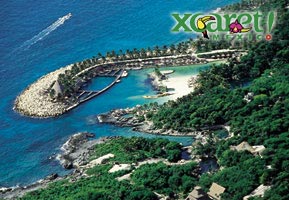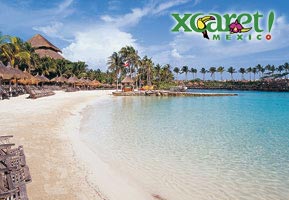Xcaret Magazine - Contoy Island
A small, partially hill-covered land mass carpeted with low vegetation, lagoons surrounded by a red and black mangroves, fine white sandy beaches shadowed by coconut palms and bathed by waters from turquoise to a magnificent green hue, is the view we have of Contoy, a small island of the Mexican Caribbean, from our boat that is a nearing its coasts after the hour-and-a-half trip from Cancun.
From far away, the sky over the island looks cloudy, as if it were covered with light, black nebulas moving uniformity in circles. As we get closer to shore, we realize that those spots are really flocks of birds. Suddenly, we find ourselves surrounded by them: they are flying overhead, and in the sea, all around the boat, thousands of them fishing, eating, and resting.
When we dock at the wooden jetty, several friendly, majestic pelicans greet us while a curious manta ray, as big as a flying saucer, comes and goes under our boat. |

The beach is the perfect complement to a day of fun

Xcaret Tropical Beach
|
|
We have arrived at Contoy Island, also known as Bird Island. The island is practically deserted, except for a fishing campsite we saw along the shore and a few scientists doing field work here. We walk down a white trail, lined with sea lilies that lead through the bushes to the Visitor Center. The complex houses a small museum and a 5-story watchtower with a panoramic mirador for an incredible view of this small, wild paradise, located where the waters of the Gulf of Mexico and the Caribbean sea meet, 19 miles north of Isla Mujeres. From up here, we can appreciate the length of the island that stretches like an arm- it is 5 miles long- in contrast with its narrowness: in some parts its only a few yards wide. Its 792-acre surface is 70 percent terra firma and 30 percent brackish water lagoons and marly soil marshes. Since there is so much water, extensive areas are covered with four species of ecologically important mangrove trees: black, red, white and "botoncillo". The rest of the land is carpeted with grass, climbing ad flowering plants, and shrubs including the sea grape and siricote. Because of the soil, tall trees are scarce. Nevertheless, Contoy Island is one of the few paces in the Mexican Caribbean where you can still find lots of healthy coconut and chit palms that have miraculously escaped the plague known as "yellow sickness" which has damaged the palm trees of the region for ten years.
From our observatory, we can admire the huge quantity of birds who call the island home. Of the 104 species registered to date, 57 are permanent lodgers, and the others are visitors. Since time immemorial, Contoy Island has been the area's most important refuge for sea, lagoon and migratory birds. This is because the island is located where the crystalline but nutrient-poor waters of the Caribbean Sea meet the turbid, fauna-plentiful waters of the Gulf of Mexico. The mixed currents produce a great quantity of plankton, the diet of the numerous fish which in turn are food for the sea birds.
Almost fifty years ago, the beauty and ecological importance of this small island of the state of Quintana Roo awoke the interest of ecologists and naturalists. To maintain its excellent state of conservation, in 1961 it was officially declared a nature reserve and wildlife Refuge. It was the first Special Biosphere Reserve in the Yucatan Peninsula, followed by Calakmul, Sian Ka'an and Yum Balan. Today, every type of excursion to the island is restricted. Nevertheless, because of their ecological vigilance, Asterix Cruises has been chosen to provide daily eco-adventure tours. With favorable weather conditions, the company guarantees the best snorkeling around in the nearby reef of Islaches, a delicate area that has remained virgin, thanks to strict compliance with established ecological regulations. Special permission was also granted to a few fishermen from Puerto Juarez and Isla Mujeres to transport passengers to the island.
Contoy Island is the ideal site for birds to nest or spend a quiet, bountiful winter. The frigate bird is the most prolific species with a current population of 6000. During reproduction time, the male inflates of bright red throat to attract the female. She, in turn, won't produce more than one chick every two years. The aerodynamic flight of this elegant creature was actually the inspiration behind French engineers in designing the Concorde. Another permanent island inhabitant is the pelican which has also given its name to the island (Contoy comes from "Pontoj" which means pelican in Mayan language). The area contains the most important nesting colony of brown pelicans along the east coast from Texas to Belize. The island also provides shelter for the brown booby, the sooty tern, the laughing gull, and the white-crowned pigeon, some of the many species that have chosen this small heaven for nesting and breeding. Bird and reptile families live together peacefully and harmoniously, since the absence of fresh water on the island makes it an inappropriate habitat for mammals.
We walk down a white path through the underbrush towards the beach. The path is lined with exotic flowers emanating a sweet aroma.
Emerald-green lizards flee as we approach, and hide under the heather and spider lilies from where they observe us. An elegant reddish egret, very rare in North America, crosses the trail in front of us and pauses to observe with its small round eyes as we pass by. The calm, romantic strand is sheltered by majestic palm trees. We break open the coconuts we find on the sand and savor the juicy flesh, comfortably seated in the shade, the tiny waves breaking around our toes. From the fishing campsite nearby, the tantalizing smell of boiled fish wafts toward us, tickling our noses and awakening our appetites as well as our interest. We decide to pay the fishermen a visit.
Even though fishing is forbidden in Isla Contoy, some fishermen are granted permission to live temporarily, during the "corrida" (migration) of the Caribbean spiny lobster which occurs between October and February. Their roué is parallel to one of the island's coasts, and fishermen take advantage of the season to catch a few days as many lobsters as they do the rest f the year.
Another authorized species is the "escribano", a small swordfish birds do not feed on because of the sharp, pointy "sword". It is strictly forbidden to fish any of the other species that proliferate in these generous coastal waters, including snails (an endangered species since 1990), shrimp, and sharks. On summer nights, beaches welcome millenary female sea turtles that come here to nest. The young of the hawksbill, green loggerhead and sometimes leatherback turtles will hatch from the hundreds of laid eggs and their instinct will lead them to the sea. They will disappear for a year or two but they always come back.
When the light begins to fade, the sun, hidden behind reddish clouds, gives way to the moon and we leave this natural sanctuary, knowing that this protected area is a very good example to follow everywhere humankind jeopardizes delicate ecosystems and Nature's harmony. |